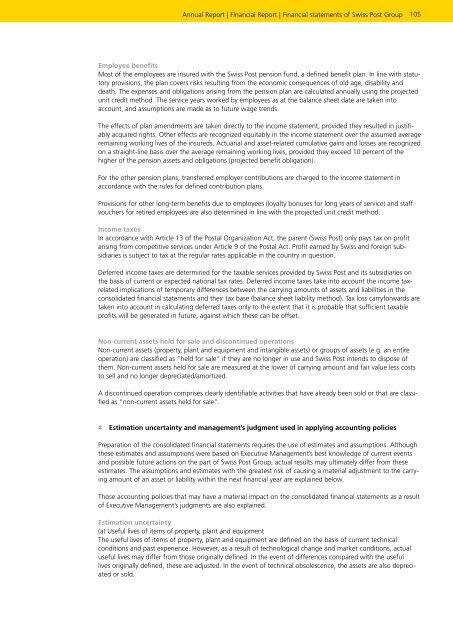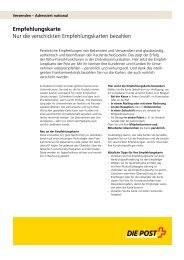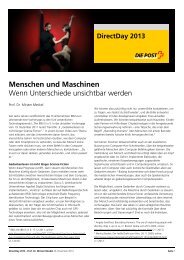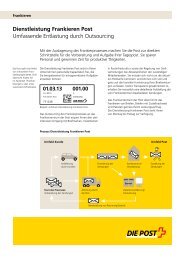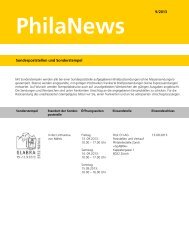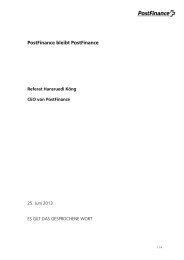Service-oriented - Die Schweizerische Post
Service-oriented - Die Schweizerische Post
Service-oriented - Die Schweizerische Post
Create successful ePaper yourself
Turn your PDF publications into a flip-book with our unique Google optimized e-Paper software.
Annual Report | Financial Report | Financial statements of Swiss <strong>Post</strong> Group<br />
Employee benefits<br />
Most of the employees are insured with the Swiss <strong>Post</strong> pension fund, a defined benefit plan. In line with statutory<br />
provisions, the plan covers risks resulting from the economic consequences of old age, disability and<br />
death. The expenses and obligations arising from the pension plan are calculated annually using the projected<br />
unit credit method. The service years worked by employees as at the balance sheet date are taken into<br />
account, and assumptions are made as to future wage trends.<br />
The effects of plan amendments are taken directly to the income statement, provided they resulted in justifiably<br />
acquired rights. Other effects are recognized equitably in the income statement over the assumed average<br />
remaining working lives of the insureds. Actuarial and assetrelated cumulative gains and losses are recognized<br />
on a straightline basis over the average remaining working lives, provided they exceed 10 percent of the<br />
higher of the pension assets and obligations (projected benefit obligation).<br />
For the other pension plans, transferred employer contributions are charged to the income statement in<br />
accordance with the rules for defined contribution plans.<br />
Provisions for other longterm benefits due to employees (loyalty bonuses for long years of service) and staff<br />
vouchers for retired employees are also determined in line with the projected unit credit method.<br />
Income taxes<br />
In accordance with Article 13 of the <strong>Post</strong>al Organization Act, the parent (Swiss <strong>Post</strong>) only pays tax on profit<br />
arising from competitive services under Article 9 of the <strong>Post</strong>al Act. Profit earned by Swiss and foreign subsidiaries<br />
is subject to tax at the regular rates applicable in the country in question.<br />
Deferred income taxes are determined for the taxable services provided by Swiss <strong>Post</strong> and its subsidiaries on<br />
the basis of current or expected national tax rates. Deferred income taxes take into account the income taxrelated<br />
implications of temporary differences between the carrying amounts of assets and liabilities in the<br />
consolidated financial statements and their tax base (balance sheet liability method). Tax loss carryforwards are<br />
taken into account in calculating deferred taxes only to the extent that it is probable that sufficient taxable<br />
profits will be generated in future, against which these can be offset.<br />
Non-current assets held for sale and discontinued operations<br />
Noncurrent assets (property, plant and equipment and intangible assets) or groups of assets (e.g. an entire<br />
operation) are classified as “held for sale” if they are no longer in use and Swiss <strong>Post</strong> intends to dispose of<br />
them. Noncurrent assets held for sale are measured at the lower of carrying amount and fair value less costs<br />
to sell and no longer depreciated/amortized.<br />
A discontinued operation comprises clearly identifiable activities that have already been sold or that are classified<br />
as “noncurrent assets held for sale”.<br />
4 Estimation uncertainty and management’s judgment used in applying accounting policies<br />
Preparation of the consolidated financial statements requires the use of estimates and assumptions. Although<br />
these estimates and assumptions were based on Executive Management’s best knowledge of current events<br />
and possible future actions on the part of Swiss <strong>Post</strong> Group, actual results may ultimately differ from these<br />
estimates. The assumptions and estimates with the greatest risk of causing a material adjustment to the carrying<br />
amount of an asset or liability within the next financial year are explained below.<br />
Those accounting policies that may have a material impact on the consolidated financial statements as a result<br />
of Executive Management’s judgments are also explained.<br />
Estimation uncertainty<br />
(a) Useful lives of items of property, plant and equipment<br />
The useful lives of items of property, plant and equipment are defined on the basis of current technical<br />
conditions and past experience. However, as a result of technological change and market conditions, actual<br />
useful lives may differ from those originally defined. In the event of differences compared with the useful<br />
lives originally defined, these are adjusted. In the event of technical obsolescence, the assets are also depreciated<br />
or sold.<br />
105


